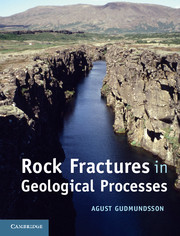Book contents
- Frontmatter
- Contents
- Preface
- Acknowledgements
- 1 Introduction
- 2 Stress
- 3 Displacement and strain
- 4 Relation between stress and strain
- 5 Loading of brittle rocks to failure
- 6 Stress concentration
- 7 Theories of brittle failure of rocks
- 8 Extension fractures and shear fractures
- 9 Displacements and driving stresses of fractures
- 10 Toughness and fracture mechanics
- 11 Field analysis of extension fractures
- 12 Field analysis of faults
- 13 Evolution of extension fractures
- 14 Evolution of faults
- 15 Fluid transport in rocks – the basics
- 16 Fluid transport in faults
- 17 Fluid transport in hydrofractures
- Appendix A Units, dimensions, and prefixes
- Appendix B The Greek alphabet
- Appendix C Some mathematical and physical constants
- Appendix D Elastic constants
- Appendix E Properties of some crustal materials
- Index
- References
12 - Field analysis of faults
Published online by Cambridge University Press: 05 June 2012
- Frontmatter
- Contents
- Preface
- Acknowledgements
- 1 Introduction
- 2 Stress
- 3 Displacement and strain
- 4 Relation between stress and strain
- 5 Loading of brittle rocks to failure
- 6 Stress concentration
- 7 Theories of brittle failure of rocks
- 8 Extension fractures and shear fractures
- 9 Displacements and driving stresses of fractures
- 10 Toughness and fracture mechanics
- 11 Field analysis of extension fractures
- 12 Field analysis of faults
- 13 Evolution of extension fractures
- 14 Evolution of faults
- 15 Fluid transport in rocks – the basics
- 16 Fluid transport in faults
- 17 Fluid transport in hydrofractures
- Appendix A Units, dimensions, and prefixes
- Appendix B The Greek alphabet
- Appendix C Some mathematical and physical constants
- Appendix D Elastic constants
- Appendix E Properties of some crustal materials
- Index
- References
Summary
Aims
Faults are measured in a very similar way as extension fractures. The main aims of this chapter are to:
Give field examples of typical faults.
Illustrate how the most important field measurements of faults are made.
Provide typical field data on dip-slip faults.
Provide field data on strike-slip faults.
Explain and discuss oblique-slip faults.
Dip-slip faults
Dip-slip faults are those where the displacement is parallel with the dip of the fault (Fig. 12.1). They include normal faults, reverse faults, and thrust faults (Figs. 8.3 and 8.8). The block above the fault plane is the hanging wall, the block below the fault plane the footwall (Fig. 12.1). Depending on the sense of slip and the fault dip, the main types of dip-slip faults are normal faults, reverse faults, thrusts, and overthrusts. More specifically, when the hanging wall moves down relative to the footwall, the fault is a normal fault. When the hanging wall moves up relative to the footwall, the fault is a reverse fault.
When the dip of a fault is less than 45° it is referred to as a low-angle fault. A low-angle normal fault is just referred to as such, but sometimes as a lag fault. However, low-angle reverse faults have special names. In general, if the dip of the reverse fault is less than 45° (for some the angle should be 30°), it is referred to as a thrust or a thrust fault.
Information
- Type
- Chapter
- Information
- Rock Fractures in Geological Processes , pp. 354 - 372Publisher: Cambridge University PressPrint publication year: 2011
